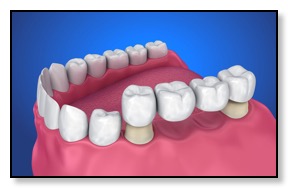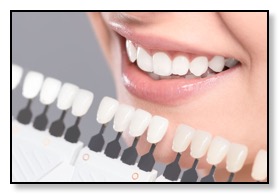What are Dental Bridges & Do I Need One?
Why Do I Need a Dental Bridge?

» Stress on adjacent teeth: The gap means you will put more bite pressure on the adjacent teeth, potentially causing them to move out of their natural position, fracture, twist, or become infected.
» Improper distribution of biting force: Teeth are meant to work together; when one or some of them are lost, the distribution of your biting force on the teeth is affected. This causes a concentration of the biting pressure on the adjacent teeth, which may lead to worn-down teeth.
» Food impaction: When you are missing a tooth or multiple teeth, the food you chew can become lodged down next to the gum. If you are not diligent about flossing, brushing and making sure this food is removed, the gum can recede and you can develop bone loss. Ultimately, you could lose the adjacent teeth and also develop gum disease.
» Change in bite: If the gap is not closed, the opposing teeth (on the opposite jaw) can extrude themselves. This means the tooth across from the now missing tooth will start to force itself out, damaging the roots, and causing you to change your bite pattern. This can lead to discomfort, bone loss, loss of teeth, and infections.
» Change in appearance: The gaps and movement of your remaining teeth can cause changes to your facial shape, espec"ally around the lips and the cheeks. When you meet people that have been without their back teeth (molars), you'll find their cheeks sink in due to the lack of support. This gives people that "aged" or "hollow-cheek" look.
» Effect on speech and pronunciation: In more severe cases, missing teeth can impede correct tongue placement, allow air to escape, and force people to alter the way they form their speech. This leads to unwanted whistles, clicks, pops, tongue noises and, worst of all, difficulty speaking clearly.
Fortunately, there are multiple ways in which your dentist can replace your missing teeth and close the gaps. The primary way of replacing teeth is to use dental implants. When implants are not an option, patients will look to dentures, partial dentures and, of course, Dental Bridges.
What are Dental Bridges?

Dental bridges are custom-made replacement tooth or teeth with crowns on either side of the gap and false tooth/teeth in the middle that literally bridge the gap. They are held in place by the crowns anchored to the teeth on either side of the gap.
Thus, you can visualize a dental bridge as an actual bridge over a river, with the crowns acting as the anchors or abutments on either side of the river, and the false tooth/teeth in between as the span or deck of the bridge. The teeth on which the crowns are fixed are called abutment teeth, and the false teeth in between are called pontics.
How are Dental Bridges Placed?
The process of placing a dental bridge is quite similar to crowning, and, like the latter, you will need to make at least two visits to your dentist.
On the first visit, Dr. Tsai will apply a local anesthetic to numb the teeth and their surrounding areas so that you don’t feel any discomfort during the procedure. She will then prepare the teeth on both sides of the gap to receive the dental crowns. The process here is similar to when placing a dental crown. She will take the impression of your teeth, from which our lab will fabricate a bridge exactly fitting your teeth. Dr. Tsai will also place a temporary bridge to be used for approximately two weeks that it takes to fabricate the permanent bridge. The temporary bridge will not only help ensure that you can smile confidently even during these two weeks but also will help you to get used to the feel of the bridge. It will also allow Dr. Tsai to address any issue that may come up.
On the second visit, usually after two weeks, Dr. Tsai will remove the temporary bridge and place the permanent one. She will make necessary adjustments to ensure that the bridge fits perfectly and then permanently cement it into place.
What are Dental Bridges Made of?

Dental bridges can be made of various materials - ceramic, porcelain, porcelain bonded to metal, or all metal (like gold or other alloys). Here at Millbrae Dental Care, we generally use all-zirconia bridges, which are strong, durable ceramic materials providing a great balance of function and aesthetics. For anterior or front teeth, we usually use a more cosmetic Empress II material which provides translucency or depth effect for a more natural tooth. However, there are times we need to use a metal substrate bridge for more support when patients have a heavy bite.
Pros and Cons of Dental Bridges
Dental bridges were once the standard of care for bridging gaps before dental implants were perfected. While they are still a viable option today, patients usually chose to avoid them and opt for dental implants to replace their missing teeth if possible. To understand whether dental bridges are right for you, let’s take a look at their pros and cons.
» Bridges can be placed with a relatively simpler and less invasive procedure as compared to implants.
» They are generally less expensive than dental implants.
» They are effective in restoring your smile and ability to speak properly.
» They can help maintain or restore your facial shape.
» They generally last 5 -15 years.
» The most common problem with bridges is recurrent decay at the margin of the bridge and on the abutment teeth. This is due to food gathering around or under the bridge and not being cleaned properly.
» The healthy adjacent teeth have to be prepared and cut down to receive the crowns, and when the bridge eventually fails, these teeth are also left useless.
» They are hard to keep clean. To clean the food impaction under the bridge, you have to thread floss under them daily or use a special tool called a Waterpik.
» Food impaction can quickly cause decay to the abutment teeth, and also cause gum disease.
» If you chip one tooth on a bridge, you have to replace the whole bridge. This can be very expensive.
» When you place a bridge, the bite pressure on the whole bridge is concentrated on the supporting or abutment teeth. The high bite pressure put on the abutment teeth tends to weaken the root structure of these supporting teeth and can lead to bone loss, root resorption, root fracture, and bridge failure.
» Lack of pressure on the ridge under the bridge can also cause bone loss through resorption.
Alternative to Dental Bridges

While bridges may be a simpler and lower-cost option, they are based on compromised teeth and usually do not last as long as natural teeth. A dental bridge may need to be replaced every 5 to 15 years, thus negating the lower cost in the long run. A dental implant, which will make up for all the disadvantages of dental bridges pointed out above, may be a viable alternative, and though it is more expensive, it may turn out to be more economical in the long run.
If you have any dental problems, or have missing tooth/teeth and are looking to bridge the gap, schedule an appointment with Dr. Tsai or give our office a call. We will help you understand the procedures of replacing missing teeth and to decide on the most suitable one to replace your missing teeth and close the gap.
How Much do Dental Bridges Cost?

This is a difficult question to answer as there are many situations, materials, areas of the mouth and insurance coverage. A general price range for standard dental bridges used to repair and cover your back teeth is $950-$1595* per unit (per tooth). When you are replacing anterior or front teeth and want a natural look to the teeth, we switch to our aesthetic labs and use material such as Empress II. These dental bridges or aesthetic bridges rage in price $1,200-$1,850* per unit (tooth). How many units do you need? A typical bridge will have at least two abutments and a pontic for each missing tooth. There are some situations you need three or four abutments to hold longer span dental bridges in place securely. Again, these prices are typical ranges. It is best, if you think you need a dental bridge, crown, veneer, or implant crown, to call Dr. Tsai and have her evaluate and provide a more detailed treatment plan with pricing and payment plan options.
As useful and beneficial as they are, dental bridges are not the always the best answer to your teeth problems. If you have any of the symptoms mentioned above, or if you think you need a dental bridge, dental crown, root canal treatment, or any other treatment, schedule an appointment with Dr. Tsai or give us a call.
Have questions about dental crowns? email or call us: (650)-583-5880
📩
Send us Email
📅
Request Appointment
* These are suggested ranges of crowns, bridge units, etc. They are not actual prices are not quotes of our prices. Prices vary with tooth number, location, color, additional procedures needed, aesthetic qualities, etc. Please ask our office for a clinical evaluation and a financial estimate for your situation.